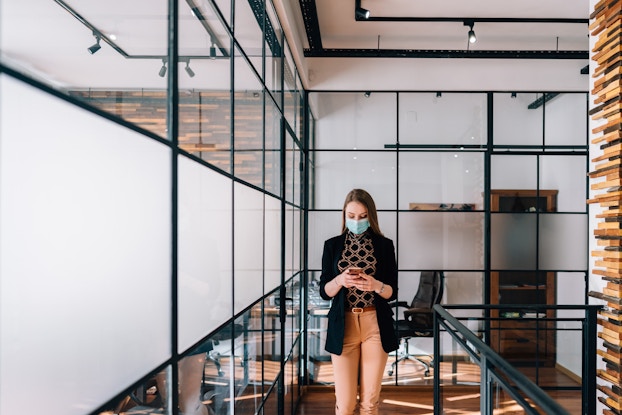
With businesses across the country reopening workspaces, offices with open layouts or dense quarters will face challenges accommodating social distancing and other new norms established by COVID-19. Real estate organizations such as CBRE, Cushman & Wakefield and the American Institute of Architects have all released suggestions of how offices can improve social distancing and sanitation to prevent the spread of COVID-19.
Here are 10 creative and practical ideas from those organizations and others on how offices can change layouts, furniture and more to adapt to the coronavirus era.
Capacity signage
Social distancing can be challenging in offices that previously packed in workers, but one important addition that can help control how many people are in various spaces is custom-made capacity signs. Offices may have had a single capacity sign before but now they could have many. Every space — whether it’s a conference room, lobby, elevator, kitchen or bathroom — could have a sign mandating the number of people that should use it to comply with state, local and other guidelines.


Check-in stations in lobbies
Whereas office lobbies may have been a place for groups to congregate before, no longer. Instead, some lobbies could be converted into health check-in stations to screen employees. Kastle Systems, a large security services provider for businesses, suggests that lobbies could “resemble airports with testing stations, screening queues, speed lanes, designated check-in times, and self-check kiosks.” If employees have a temperature or are showing visible signs of sickness, they’d then be asked to go home.
Flexible desk spaces
Shifting workers from dedicated desks to spaced out flexible desks may be one way to accommodate returning workers in some offices. As workers may not come in every day to meet occupancy requirements, this means more space can become general purpose. JPMorgan Chase, for example, is planning to shift employees from dedicated office desks to a flexible desk arrangement with deep cleaning happening every night.
Hand sanitizer and disinfectant stations
Hand sanitizer and disinfectant wipes have become much more popular since COVID-19 pandemic started in early 2020. Many offices will likely invest in hand sanitizer and other disinfectant products and create stations around the office so people can get a quick squirt of sanitizer, get a wipe to use before a conference room meeting, or the like.
With many employees working remotely and likely a smaller percentage planning to come in than normal, one smart way to redesign the office is to facilitate meetings in newly dedicated video call rooms.
Improved air filtration
Research shows that one of the most prominent ways COVID-19 spreads is through “respiratory droplets produced when an infected person coughs, sneezes, or talks.” As such, excellent air filtration will be a priority for offices that are reopening. CBRE recommends that office buildings work to “increase outside air ventilation rates and filtration efficiency” or to install new filtration systems altogether when needed.
Plexiglass barriers
With open office spaces falling out of favor during COVID-19, a way businesses can help workers socially distance is through the addition of Plexiglass barriers. These large plastic sheets, which are now being used as sneeze guards in stores, can also be designed to block employees off from each other. The plus side to using the barriers is that employees can still see each other and be able to hear one another when speaking while also risking less exposure to the virus.
Social distancing floor indicators
One novel way to encourage social distancing, as outlined by Cushman & Wakefield’s Netherlands office, is to use floor stickers that show how far six feet actually is. Stickers (or custom carpets) can be placed underneath where employees sit in order to show exactly how far other employees should stay from that person when conversing.
Touchless everything
With COVID-19 able to spread on surfaces, offices will likely invest in touchless devices wherever they can reasonably be installed. For example, entry and exit doors can either automatically open or require key fobs to open doors instead of requiring door handles. And in bathrooms, a common place for germs to spread, offices can install automatic sinks, soap dispensers and dryers.
UV-C lamps
While UV-C lamps may have previously only been found in places like hospitals, these devices that disinfect air and surface particles could soon find a place in busy office spaces. While these lamps can be dangerous if people are too close to them while in use, they could be used after hours as part of a coronavirus-inspired deep cleaning routine.
Video chat rooms
With many employees working remotely and likely a smaller percentage planning to come in than normal, one smart way to redesign the office is to facilitate meetings in newly dedicated video call rooms. For example, design firm Bergmeyer told CityLab it planned to “turn all of its smaller conference rooms into video chat spaces” and is “experimenting with backgrounds that work well for remote meetings.”
CO—is committed to helping you start, run and grow your small business. Learn more about the benefits of small business membership in the U.S. Chamber of Commerce, here.







